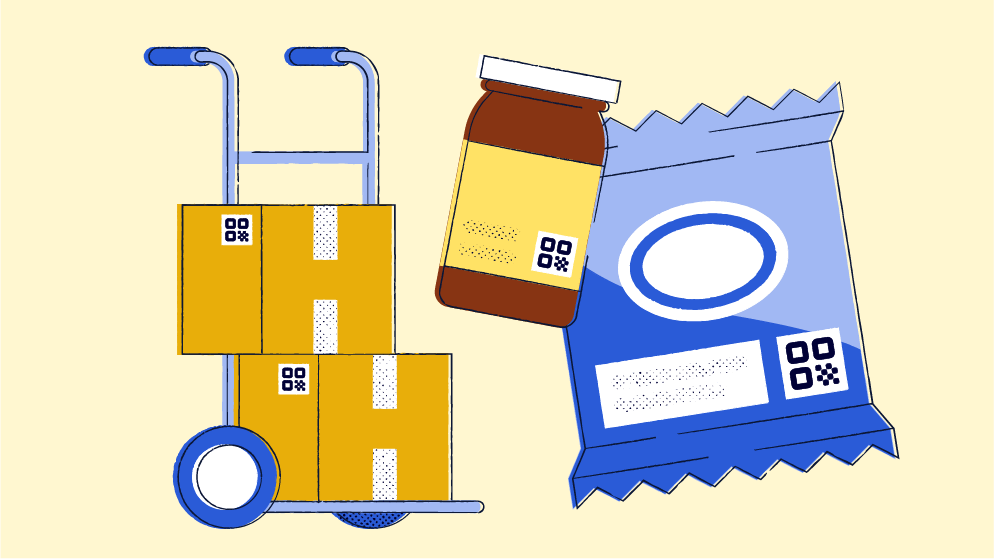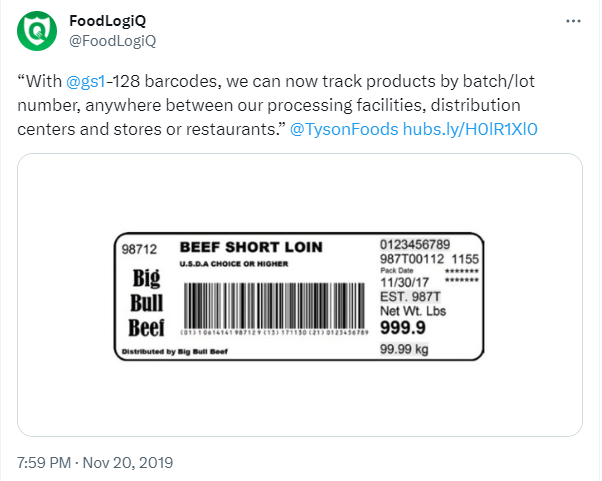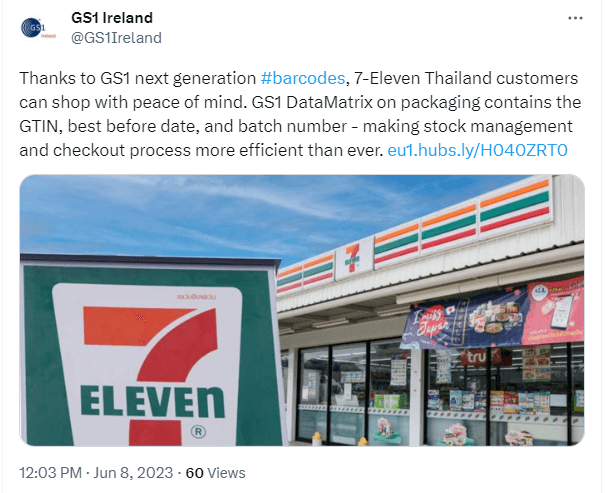
GS1 barcodes are commonly used in industries such as retail, manufacturing, and consumer packaged goods (CPG). GS1, the nonprofit organization responsible for developing and maintaining global standards for barcodes, has played a crucial role in advancing their adoption worldwide. Dive in to learn more about the ins and outs of GS1 barcodes, how they work, and some exciting use cases!
What is a GS1 barcode?
GS1 barcodes are globally recognized barcodes that adhere to a global system of standards. These barcodes contain key identifiers and attributes, such as Global Trade Identification Numbers (GTINs), locations, shipments, serial and batch numbers, and dates. GS1 provides many types of barcodes, including 1D barcodes like UPC (Universal Product Code) barcodes and 2D barcodes like QR Codes.
How does a GS1 barcode work?
GS1 is the designated provider of GS1 barcodes. So, when you register your product with them, you can obtain a GTIN. Think of this number as your product’s unique identification—a fingerprint that distinguishes your product from others in the market.
Today, GS1 is the only place where you can get a GTIN. Once you have one, you can confidently sell your products, knowing they meet global standards. Plus, many retailers, both online (like eBay, Amazon, and Google) and offline (like Walmart), require GTINs and GS1 barcodes for the products that they sell.
Types of GS1 barcodes
GS1 barcodes can be categorized into two groups: 1D barcodes (linear) and 2D barcodes. In the section below, we’ll explain how to identify each type.
1D barcodes
One-dimensional barcodes, also known as linear barcodes, are usually identifiable by their black vertical lines. While there are several linear barcodes used for a plethora of diverse use cases, we’ll cover three common ones we may see almost every day.
UPC
A UPC barcode is a linear barcode that is made up of 12 unique digits (a GTIN) which contains key information about the product, such as the price. This kind of barcode is used in the retail industry worldwide, including products like clothing, groceries, cosmetics, and electronics.
These barcodes are incredibly common, whether we realize it or not. We encounter them every single day—at the supermarket, on online delivery packages, and on clothing labels.
GS1 DataBar
These zebra-striped barcodes are usually found on fresh produce labels. This particular barcode family has a total of seven family members, with the majority of them used at the retail point of sale (POS).
The GS1 DataBar stores essential information like the item’s weight, product batch number, and expiration date—which are all vital identifiers when selling items with a limited shelf life.
GS1-128
Used by most large retailers, this type of linear barcode helps trace and track items through global supply chains. They store product attribution data such as batch numbers, quantity, weight, and the best-before date.
Known for its versatility, these barcodes prove to be useful and effective in logistics and general distribution environments. When printed on logistics labels, it encodes one of two codes: the GTIN or the Serial Shipping Container Code. It’s also not uncommon for shipping labels to have more than one GS1-128 barcode printed on them.
2D barcodes
GS1 has established standards for at least five distinct types of two-dimensional barcodes. Among the most recognizable are the QR Code and the GS1 DataMatrix.
GS1 QR Code
This barcode, which can contain a GS1 Digital Link, allows consumers to access linked web content by scanning the product QR Code on the packaging. Retailers can embed a variety of online resources in the packaging from nutritional information and recipes to recycling instructions and product ingredients. This 2D barcode is extensively used in the CPG and retail industry.
Big news alert: Bitly has announced its increased investment in the implementation of GS1 standards to support retailers and CPG companies. We aim to support our customers in creating more connections with their audiences with GS1-compliant Bitly QR Codes.
Check out the full announcement to learn more!
DataMatrix Barcode
This barcode is typically found on medical devices, pharmaceuticals, and other items in the healthcare industry. However, its applications extend across a wide range of industries, including labeling on fresh foods, construction materials, and various other products. And just like the QR Code, the DataMatix can store a digital link that connects users to an online world of resources.
GS1 barcode use cases
There are many reasons why companies have turned to GS1 in order to streamline their processes and track their products. Whether your goal is enhancing inventory management, accuracy, or overall efficiency, GS1 barcodes can address all these needs.
In this section, we’ll dive into two industry use cases in CPG and retail to provide you with insights into how they can enhance your business operations.
Note: These examples were found during our online research while writing this article.
Consumer packaged goods: Tyson Foods
Tyson Foods, a global leader in meat and poultry production, distributes its product line to retailers and food providers across the U.S. and 130 countries around the world. Utilizing game-changing GS1 barcodes, Tyson is able to trace their products by batch number, ensuring accurate visibility of product locations from distribution centers to stores.
The remarkable adoption of GS1-128 barcodes brought substantial benefits to both customers and the business. For instance, the barcodes aided in the precise measurement of products with varying weights, a common scenario in the fresh food industry. This enabled Tyson to accurately assign pricing according to product weight, consequently reducing customer disputes related to billing.
Harnessing the power of the GS1 barcode to handle pesky operational tasks allowed them to shift their focus toward customer satisfaction, bringing them closer to establishing a loyal customer base.

Retail: 7-Eleven Thailand
7-Eleven Thailand aimed to set a new standard within their stores, one focused on enhancing consumer safety and satisfaction. To attain this goal, they sought guidance from GS1, which provided them with the optimal solution. After careful deliberation, 7-Eleven opted to enhance its product packaging by incorporating GS1 DataMatrix barcodes.
Numerous adaptations were undertaken to fully harness the advantages of these barcodes. This involved modifying the packaging of their branded products to accommodate the new barcode size.
They also updated their printers and software to automate the barcode printing process, ensuring they were encoded with GTINs and best-before dates. As a final step, they upgraded their point-of-sale system to enable cashiers to seamlessly scan the barcodes.
By making these changes, they got better at keeping track of their stock, saved time, cut down on mistakes, and most importantly, made sure their products didn’t go past their best-before dates.
Need an update on retail marketing? Brush up on your retail marketing skills here!

GS1 barcode FAQs
Still unsure of how GS1 barcodes work? Find answers to your frequently asked GS1 barcode questions here.
Is GS1 the same as UPC?
No. GS1 is a non-profit organization that maintains a system of global standards for barcodes. One of GS1’s services is providing its customers with Universal Product Codes (UPC), a barcode that is printed on almost all consumer products.
What is the difference between a GS1 barcode and a normal barcode?
GS1 barcodes contain a globally recognized identifier, known as a GTIN, making it possible to identify and track your products anywhere in the world. This is because GS1 established a globally accepted, understood, and trusted set of standards. There is no guarantee that normal barcodes will follow the same global standards as GS1 barcodes, as they weren’t created by GS1. Keep in mind that not all barcodes are made equal.
Who needs a GS1 barcode?
If you’re a company or brand with products to sell, getting a GS1 barcode is a smart move. It gives each product a unique identification, which is crucial if you’re expanding your business. This barcode shows customers that your products are authentic and trustworthy, whether they’re buying them in a store or online. And remember, if you’re thinking about selling on platforms like Amazon, you’ll need one of these GS1 barcodes.
Can I make my own GS1 barcode?
No. You can only make your own GS1 barcode once you have your GTIN provided by GS1.
Get a head start with Bitly
The GS1 organization has also made an important announcement about their process of gradually phasing out UPC barcodes in favor of 2D barcodes. The global migration has already begun and is expected to be implemented by 2027. This shift is expected to bring significant changes to the retail, CPG, and healthcare industries, so stay tuned for further updates! And with Bitly’s planned investment in GS1 technology, you definitely don’t want to miss out.
Step into the future with Bitly by signing up today!